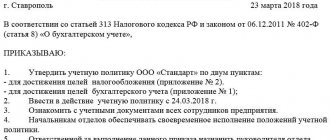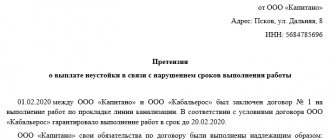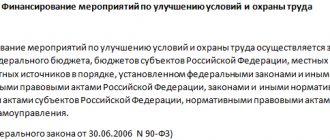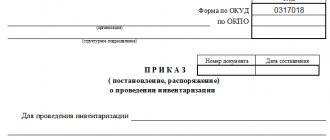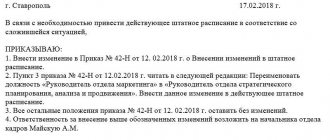According to the instructions
The job description includes a list of functional responsibilities, indicates the subordination structure and limits of responsibility, lists the qualification requirements for the position, and contains other aspects depending on the personnel policy of the organization. The Labor Code does not oblige employers to have such a document, but it is very useful. The labor function is indicated in the employment contract, but it is inconvenient to describe the responsibilities in detail there, so a separate document is used for this. It is a local regulatory act of the organization and is approved like other regulatory acts. It can be an annex to an employment contract or an independent LNA. When making changes, we recommend that you follow the letter of Rostrud No. 4412-6 dated October 31, 2007.
The introduction of new DI occurs when something changes in the existing ones (for example, due to the emergence of professional standards, there is a need to revise qualification requirements and functions for positions) or new positions appear. Government agencies receive requests for changes from ministries and departments to which these structures are subordinate.
Why do you need a job description?
Requirements for the availability of a specialist’s job description in organizations exist only in government agencies. Some industry standards require regulation of job responsibilities:
- health workers - No. 323-FZ;
- private security guards - Order of the Ministry of Internal Affairs of Russia No. 960 of 18/22/2011
The rest are guided by their own needs regarding the need for job descriptions for employees in the organization. Perhaps in small companies they are not needed, but in large enterprises, without specifying activities, it is difficult to monitor the quality performance of duties.
Enterprise job descriptions (JI) are a double-edged tool; both the employee and the employer need them. Rostrud has a similar opinion - letter No. 3042-6-0 dated August 9, 2007.
| Example If, in accordance with the job description, the seller is not required to clean his sales place, he has the right to refuse cleaning without disciplinary consequences. On the contrary, the seller’s job responsibilities are combined with cleaning and this is included in the instructions; the employer can impose penalties on this employee if he refuses to clean. |
An employee’s job description will help in the following cases:
- in court as evidence of performance/non-performance of official duties;
- justify refusal to hire;
- check the employee’s qualifications during the probationary period;
- distribute or specify functions between employees if they occupy the same positions.
| Advice To increase labor efficiency, the employer in the staff job descriptions has the right to distribute responsibilities between employees occupying the same positions. At the same time, the staffing table establishes the same salaries for such positions. Allowances, additional payments and other payments may vary depending on qualifications, complexity of work and other indicators. |
Is it necessary to prepare an order?
The question often arises whether it is necessary to approve a job description by order. There is no mandatory requirement.
In accordance with clause 5.16 of GOST R 7.0.97-2016, approval is carried out either by an official, or by an administrative document, or by a decision of a collegial body. Based on this, the job description is approved by order or by the head of the organization. The approval stamp is placed in the upper right corner.
This is what the manager’s approval stamp looks like:
| I APPROVED Director of the State Budget Educational Institution of Children's and Youth Sports School "ALLUR" Ivanov I.I. Ivanov 12.12.2020 |
This is what the approval stamp of an administrative document looks like:
| APPROVED by order of GBOU DOD SDYUSSHOR "ALLUR" dated 12/12/2020 No. 99-od |
The company itself decides how to approve new job descriptions and reflects this in its internal office regulations.
Large organizations develop special regulations to approve the company’s local regulations. Each organization acts as it pleases.
ConsultantPlus experts analyzed who approves and signs job descriptions in the organization. Use these instructions for free.
to read.
Order for approval of job description: sample
The law does not provide for clear requirements for orders introducing DI. Therefore, when publishing it, you should be guided by the general rules for such documents. Some information must be specified in it:
- Document Number;
- date and place of its publication;
- Company name;
- a complete list of instructions approved by the order.
The order must indicate the official responsible for its execution. The document must be signed by this person and the head of the organization. It can be written by hand or printed on a printer.
After the document is signed by the manager, all employees affected by them are introduced to the new instructions against signature.
How to create an order
There are no special requirements for compilation. There are recommended forms from various departments. It is formatted as follows:
- On the organization's letterhead.
- Has the necessary details: date, number, place of publication (locality), name of the document.
- The stating part contains the rationale and reasons for the creation. For example: “In connection with the introduction of a new position”, “In connection with the renaming of the department”, a reference to a normative act (approved professional standard, order of a specific department) is possible.
- The word "I ORDER".
- Administrative part. Sample text: “Approve ________ from __.__.___ (date) job description for the position ______________. The instruction dated __.__.____ (date) is declared invalid. Inform all interested parties. Entrust control over execution to ____________.”
- Manager's position, signature, transcript.
Sample
Here is an example of an order approving a job description in the new edition:
Order on approval of job descriptions (Russia)
The order approving the job description (hereinafter - JI), like the instruction itself, is not mandatory documentation, but they are widely used, especially in large organizations. Moreover, they apply both to managers and specialists, and to ordinary workers. This allows the employer to protect himself from groundless claims from staff, and the employees themselves from being assigned functions that are not part of their responsibilities.
Sometimes adjustments have to be made to the DI, this may depend on the situation in the company and its needs. In this case, it is also necessary to issue an order that will approve and make changes.
The formation of DI at an enterprise is usually carried out by department heads. The finished document is reviewed and edited by the company's lawyer or third-party legal counsel. Such a check is necessary to exclude possible violations of civil and labor legislation of the Russian Federation.
As we said above, it is not necessary to issue an order approving a new job description. Often, to approve a DI, it is enough to simply endorse it with the signature of the head of the organization. But in cases where the enterprise is quite large with the corresponding document flow, it may be easier for the manager to approve instructions with one order than to sign a large number of documents.
The issuance of an order must be justified. In the text of the order, as a basis, you can indicate a similar wording: “For the effective organization of the labor process and in order to maintain labor discipline, I order...”.
Any authorized person of the company can draw up an order, unlike the job description itself:
- legal advisor;
- HR employee;
- clerk;
- manager's secretary, etc.
The main requirement for an official is a clear knowledge of the requirements for the preparation of such documents.
Document storage period
We determine the retention period based on which orders the order approving the job description relates to - for the main activity; is stored permanently or until the liquidation of the organization (for companies that are not sources of acquisition of state archives) (clause 19 of the List approved by the Federal Archival Agency on December 20, 2019). Individual DI must be kept in the personal files of employees for 75 years if approved before 01/01/2003, and 50 years if after. Standard DIs are stored for 3 years after they are replaced with new ones (clauses 442, 443 of the List of standard management archival documents, approved by order of the Federal Archive No. 236 of December 20, 2019).
Instructions for office work
This instruction defines the rules for working with documentation within the organization in accordance with the requirements of current legislation and determines the responsibility of employees when working with documents.
It is necessary to familiarize the contents of the instructions not only with the office management service staff, but also with all personnel who work with documents. Also, the instructions must be familiarized with the signature of new employees enrolled in the organization’s staff.
The process of developing office management instructions consists of the following stages:
- collection and analysis of information;
- preparation of the project and coordination with interested employees;
- issuance of an order approving and putting the instructions into effect.
When to include individual job descriptions in the list of personnel affairs?
A.P. answers the question. Vorushina, head of the acquisition department of the State Archive of Kuzbass.
Question
When to include individual job descriptions in the list of personnel affairs? By the year in which they were replaced with new ones or by the year of approval?
Answer
A job description is an internal organizational and administrative document of the organization, containing a specific list of the employee’s job responsibilities, taking into account the peculiarities of the organization of production, labor and management, his rights and responsibilities, as well as the qualification requirements for the position held. Job descriptions can be standard or individual.
A standard job description establishes a general description of the work and the goals of the activity, contains generalized formulations of labor functions and identical, repetitive labor actions that are performed in the specified position, as well as rights and responsibilities. In practice, such instructions are most often local regulations of the organization.
For example, if Siberian Networks LLC has developed a standard job description for an engineer of category I in the technical control department, then on the basis of such instructions several engineers of category I can work in the technical control department (if they perform the same job function). This instruction is universal, that is, it applies to all employees working in the same position.
An individual job description assigns specific job responsibilities that a specific employee performs (indicating his last name, first name, patronymic) at his assigned workplace in a specific structural unit.
For example, Siberian Networks LLC may have an individual job description for the chief specialist of the sales department A.O. Ermolaeva.
The List 2019[1] contains two articles that establish storage periods for job descriptions - 442 and 443. Currently, the storage period for standard instructions is three years after replacement with new ones. For comparison: in the no longer valid List of 2010[2], standard instructions (regulations) had a permanent shelf life, which means they had to be included in the inventory of permanent storage cases.
The job description is an administrative document (or is approved by it), which means that the basic principles of grouping into cases by type of document and chronology with related appendices are applicable to it [3]:
- If rules, regulations, instructions, regulations are approved by separate administrative documents (orders or instructions) and are appendices to them, then they are included in the file along with the documents by which they were approved.
- If rules, regulations, instructions, regulations are approved as independent documents, they are formed into separate cases.
- Orders for personnel are included in files in accordance with their storage periods. At the same time, orders for personnel with a storage period of “75 years EPK” or “50 years EPK” are placed in files separately from documents on personnel with a storage period of “5 years”.
- With large volumes of documents, orders on personnel relating to various aspects of personnel management (hiring, relocation, dismissal, business trips, bonuses, etc.) can be grouped into separate cases (for example, the title of the case may look like this: “Orders of the General Director No. 1–139 on the dismissal of employees”).
Taking these principles into account, there may be three options for doing business with job descriptions , but we can only recommend the first and second options.
Option 1. Formation of job descriptions of employees into separate cases
In accordance with clause 5.10 of GOST R 7.0.97-2016[4], the date of the document corresponds to the date of signing (approval) of the document or the date of the event recorded in the document. In accordance with clause 5.16 of GOST R 7.0.97-2016, the approval stamp is affixed to a document if it is approved by an official, an administrative document (resolution, decision, order, order) or a decision of a collegial body.
Clause 4.28 of the Rules of 2015[5] states that the date of cases containing administrative, creative and other documentation (reports, letters, transcripts), for which precise dating is important, as well as for cases consisting of several volumes (parts) , are the dates (day, month, year) of registration (composition, receipt) of the earliest and latest documents included in the case (last dates of cases, documents). Consequently, the individual job description must be included in the inventory of personnel affairs (Example 1) in the annual section in which it was approved (including by the administrative document).
As a rule, individual instructions for employees are drawn up new for the employee (or employees), and before that, the employee’s “job load” is adjusted in orders for personnel. This means that the corresponding orders will be formed as part of volumes of orders for personnel.
For example, during 2015, Siberian Networks LLC compiled and approved a new individual job description for two administrative and management personnel specialists. These instructions will go into another case and will be reflected in the annual section of the inventory of cases for 2015 (Example 2).
Option 2. Formation of employee job descriptions as part of his personal file
If an organization maintains and documents employees’ personal files for long-term storage, then it is possible to create an individual job description as part of the employee’s personal file, since the storage periods for these documents are the same. This means that such an individual job description can be included in the annual section of the inventory (Example 3) in which the employee was dismissed, in which his personal file was entered, containing an individual instruction with possible additions and changes to it.
Remember that personal files are an example of a moving file, since they include documents that are generated during the entire period of the employee’s work in the organization. This means that if an employee was transferred to a new position, then the new job description will also be included in the personal file. This will be reflected in the internal inventory of the personal file (Example 4). The entry in the annual section of the inventory will be the same as in Example 3.
EXAMPLE 4
Internal inventory of personal documents
INTERNAL INVENTORY
documents in case No. 781
Option 3. If the organization does not have a practice of creating personal files, create job descriptions for employees, which are appendices to employment contracts, as part of files with employment contracts
Not all organizations maintain personal affairs, and all organizations accumulate employment contracts.
In this case, the storage period for the job description will correspond to the storage period for the employment contract, in accordance with Art. 435 of the 2022 List it amounts to “50/75 years of EPC”. This will also be reflected in the inventory of personnel cases (Example 5).
An employment contract is a document that contains the date of signing (conclusion of the contract). This date must coincide with the date of signing the individual job description (in any case, it must be one calendar year). Therefore, it is logical to include job descriptions with contracts in the annual section of the inventory “by year” of the conclusion of the contract, observing the chronological sequence of employment contracts in the case (from early to late).
If the job description is an annex to the employment contract, then it may change if changes are made to the employment contract itself. For example, an additional agreement is concluded. In such cases, it is preferable to create separate folders “Employment contracts of employees”. These files should have internal document inventories, and the documents should be arranged in the file in alphabetical or chronological order.
If there are additional agreements to employment contracts and new job descriptions, then the question of how to reflect them in the annual section of the inventory remains open. An employee may work for an organization for an extended period of time (that is, several calendar years) and have multiple additional agreements and updated individual job descriptions dating from different years. Therefore, adding employment contracts and additional agreements to the inventory, as well as individual job descriptions with changes to annual sections corresponding to the year of their conclusion and signing, means that information on one employee will be “distributed” across several annual sections (and across several cases). ) inventory of personnel cases. Such an inventory will be very inconvenient to use when recording cases and searching for the necessary information.
We do not recommend using this option for working with job descriptions. We believe that it is better to take them into account as part of the employee’s personal file.
The option you choose for creating job descriptions must be fixed in the nomenclature of cases (Examples 6, 7), since the nomenclature of cases is the basis for the formation of the organization’s documentary fund and is intended for grouping executed documents into cases, systematizing and recording cases.
[1] Hereinafter – a List of standard management archival documents generated in the course of the activities of state bodies, local governments and organizations, indicating their storage periods (approved by order of the Federal Archive of December 20, 2019 No. 236).
[2] Hereinafter – List of standard management archival documents generated in the process of activities of state bodies, local governments and organizations, indicating storage periods (approved by order of the Ministry of Culture of Russia dated 08/25/2010 No. 558 (as amended on 02/16/2016 ); lost force due to the publication of the order of the Ministry of Culture of Russia dated December 17, 2019 No. 1964).
[3] See paragraph 1.1.2 of the Guidelines for the application of the Rules for organizing the storage, acquisition, recording and use of documents of the Archival Fund of the Russian Federation and other archival documents in government bodies, local governments and organizations (VNIIDAD, 2016).
[4] Hereinafter – GOST R 7.0.97-2016 “System of standards for information, library and publishing. Organizational and administrative documentation. Documentation requirements."
[5] Rules for organizing the storage, acquisition, recording and use of documents from the Archival Fund of the Russian Federation and other archival documents in government bodies, local governments and organizations (approved by order of the Ministry of Culture of Russia dated March 31, 2015 No. 526).
11.11.2021, 12:05
Subscribe to the magazine
